109 UMMA Objects
109 UMMA Objects

Chinese (Chinese (culture or style))
Bowl
14th century
Gift of Toshiko Ogita in memory of Tomoo Ogita
1987/1.306
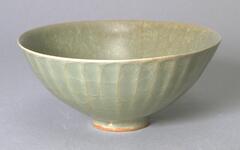
Chinese (Chinese (culture or style))
Bowl
13th century
Museum purchase for the James Marshall Plumer Memorial Collection
1964/2.73

Chinese (Chinese (culture or style))
Covered Five-tube Jar
10th century
Gift of Mrs. Henry Jewett Greene for The Mr. and Mrs. Henry Jewett Greene Memorial Collection
1971/2.74A
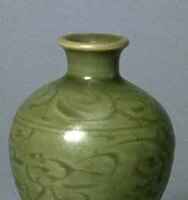
Chinese (Chinese (culture or style))
Vase
1368 – 1450
Gift of Mrs. Henry Jewett Greene for The Mr. and Mrs. Henry Jewett Greene Memorial Collection
1971/2.87
![<p>This type of bowl was extensively produced throughout the 12th century. The outer wall is decorated with incised and raised deisgn of a two-tiered lotus petal. The glaze was oxidized, producing yellow-green color, but the application of glaze to the entire foot and the use of quartzite spurs indicate that this was produced as a high-quality item.<br />
[<em>Korean Collection, University of Michigan Museum of Art</em> (2014) p.103]</p>
It has a wall gently curving from the mouth toward the bottom before angeling in sharply close to the foot. There is a lotus petal on exterior. The color is brown. <p>This type of bowl was extensively produced throughout the 12th century. The outer wall is decorated with incised and raised deisgn of a two-tiered lotus petal. The glaze was oxidized, producing yellow-green color, but the application of glaze to the entire foot and the use of quartzite spurs indicate that this was produced as a high-quality item.<br />
[<em>Korean Collection, University of Michigan Museum of Art</em> (2014) p.103]</p>
It has a wall gently curving from the mouth toward the bottom before angeling in sharply close to the foot. There is a lotus petal on exterior. The color is brown.](/media/W1siZiIsIjIwMjIvMDUvMjUvMTBnN25oa2prcF9kZWZhdWx0LmpwZyJdLFsicCIsInRodW1iIiwiMjQweDIwMCJdXQ?sha=225012457d334d64)
Korean (Korean (culture or style))
Bowl with carved lotus pattern
12th century
Transfer from the College of Architecture and Design
1972/2.78
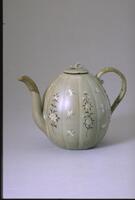
Korean (Korean (culture or style))
Ewer in the shape of a melon with inlaid floral and butterfly designs
1100 – 1150
Gift of Mrs. Caroline I. Plumer for the James Marshall Plumer Collection
1973/2.33
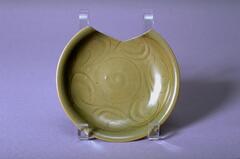
Chinese (Chinese (culture or style))
Bowl
12th century
Gift of Willard A. and Marybelle Bouchard Hanna
1991/2.13
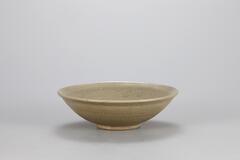
Chinese (Chinese (culture or style))
Bowl
11th century
Gift of Mr. Jennis R. Galloway through the Friends of the Museum of Art
1972/1.154
![<p>This bowl is typical of early-Goryeo celadon in terms of shape and pattern. Similar examples have been excavated from sedimentary layers from the Kiln no. 10 at Yongun-ri, Gangjin-gun, Jeollanam-do. The entire inner wall is decorated with chrysanthemum sprays incised in fine lines. Chrysanthemum spray design is commonly found in Goryeo celadon produced between the 10th and the 11th centuries along with the motifs of chrysanthemum, scroll, cloud, parrot, and wave. The design is resemblent to those found in Yue ware, but the clay and glaze were sintered better and the glaze was exquisitely fused to turn into the beautiful color without crackles. Six refractory spurs were used to support the bowl during firing. The bowl was restored after a breakage into two halves.<br />
[<em>Korean Collection, University of Michigan Museum of Art </em>(2014) p.92]</p>
<br />
Stoneware bowl with celadon glaze. The bowl is decorated by an incised line stretching parallel to the rim, bounding a chrysanthemum design below. <p>This bowl is typical of early-Goryeo celadon in terms of shape and pattern. Similar examples have been excavated from sedimentary layers from the Kiln no. 10 at Yongun-ri, Gangjin-gun, Jeollanam-do. The entire inner wall is decorated with chrysanthemum sprays incised in fine lines. Chrysanthemum spray design is commonly found in Goryeo celadon produced between the 10th and the 11th centuries along with the motifs of chrysanthemum, scroll, cloud, parrot, and wave. The design is resemblent to those found in Yue ware, but the clay and glaze were sintered better and the glaze was exquisitely fused to turn into the beautiful color without crackles. Six refractory spurs were used to support the bowl during firing. The bowl was restored after a breakage into two halves.<br />
[<em>Korean Collection, University of Michigan Museum of Art </em>(2014) p.92]</p>
<br />
Stoneware bowl with celadon glaze. The bowl is decorated by an incised line stretching parallel to the rim, bounding a chrysanthemum design below.](/media/W1siZiIsIjIwMjIvMDkvMjQvM2djdWZxdmhieV9kZWZhdWx0LmpwZyJdLFsicCIsInRodW1iIiwiMjQweDIwMCJdXQ?sha=8591e65ef730993a)
Korean (Korean (culture or style))
Bowl with Chrysanthemum Design
900 – 1099
Gift of Bruce and Inta Hasenkamp and Museum purchase made possible by Elder and Mrs. Sang-Yong Nam
2004/1.220
![<p>This bowl has a narrow foot and a ared mouth. is type of bowl was produced in large quantities from the 11th century to the 12th century. Its inner wall has mold-impressed peony sprays. The entire body of the bowl is glazed, including the inside of the foot, but the glaze on its rim of the foot was wiped away, on which refractory spurs were adhered to for ring. Parts of the inner surface show ne crackles, while the inner bottom was stained with greenish-brown iron spots. One part of the rim was damaged and subsequently repaired. Glaze applied to the outer surface has partially owed downwards, resulting in an uneven surface, but the glaze and clay are quite well fused and sintered.<br />
[<em>Korean Collection, University of Michigan Museum of Art</em> (2014) p.93]</p>
<br />
The celadon bowl has straight-lined sides. The surface is evenly coated with a dark bluish green glaze. The celadon bowl rests on a rather tall foot, which was hollowed out from the bottom. The designs are present only on the inside <p>This bowl has a narrow foot and a ared mouth. is type of bowl was produced in large quantities from the 11th century to the 12th century. Its inner wall has mold-impressed peony sprays. The entire body of the bowl is glazed, including the inside of the foot, but the glaze on its rim of the foot was wiped away, on which refractory spurs were adhered to for ring. Parts of the inner surface show ne crackles, while the inner bottom was stained with greenish-brown iron spots. One part of the rim was damaged and subsequently repaired. Glaze applied to the outer surface has partially owed downwards, resulting in an uneven surface, but the glaze and clay are quite well fused and sintered.<br />
[<em>Korean Collection, University of Michigan Museum of Art</em> (2014) p.93]</p>
<br />
The celadon bowl has straight-lined sides. The surface is evenly coated with a dark bluish green glaze. The celadon bowl rests on a rather tall foot, which was hollowed out from the bottom. The designs are present only on the inside](/media/W1siZiIsIjIwMjIvMDkvMjQvOWpqdXU4d2plel9kZWZhdWx0LmpwZyJdLFsicCIsInRodW1iIiwiMjQweDIwMCJdXQ?sha=d6b4e1202cb44ca4)
Korean (Korean (culture or style))
Conical bowl with molded floral design
12th century
Gift of Bruce and Inta Hasenkamp and Museum purchase made possible by Elder and Mrs. Sang-Yong Nam
2004/1.222
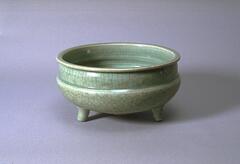
Chinese (Chinese (culture or style))
Incense Burner
15th century
Gift of Domino's Pizza, Inc.
1993/1.108
![<p>This celadon bowl is undecorated. The glaze is poorly fused and is generally opaque. The foot is low and displays traces of sand supports. The sand, stuck to the foot and the outer base, suggests that the bowl was placed on the kiln floor during ring. Glaze had run down to the outer wall of the foot and accumulated, in parts.<br />
[<em>Korean Collection, University of Michigan Museum of Art</em> (2014) p.97]</p>
<br />
shallow bowl, grey color, sanf grit on foot, made in Boryung kiln of ching chung nam-do, often found in tombs in Kangwa Island, 13th century, diameter 6+13/16 inches, height: 1+7/8 inches <p>This celadon bowl is undecorated. The glaze is poorly fused and is generally opaque. The foot is low and displays traces of sand supports. The sand, stuck to the foot and the outer base, suggests that the bowl was placed on the kiln floor during ring. Glaze had run down to the outer wall of the foot and accumulated, in parts.<br />
[<em>Korean Collection, University of Michigan Museum of Art</em> (2014) p.97]</p>
<br />
shallow bowl, grey color, sanf grit on foot, made in Boryung kiln of ching chung nam-do, often found in tombs in Kangwa Island, 13th century, diameter 6+13/16 inches, height: 1+7/8 inches](/media/W1siZiIsIjIwMjIvMDkvMjQvOHE1b3plcHhsc19kZWZhdWx0LmpwZyJdLFsicCIsInRodW1iIiwiMjQweDIwMCJdXQ?sha=c943e4400629e91b)
Korean (Korean (culture or style))
Kanghwa Bowl
12th century
Gift of Bruce and Inta Hasenkamp and Museum purchase made possible by Elder and Mrs. Sang-Yong Nam
2004/1.212
Loading…
